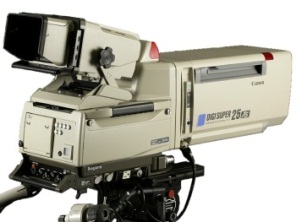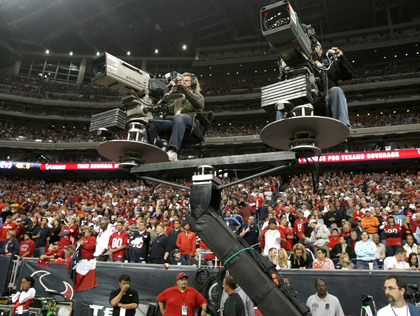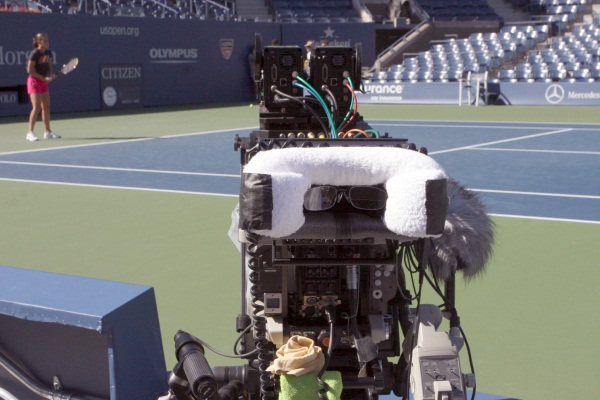STATE OF THE ART:
A Must-Read Primer On The Latest Innovations
In The Studios / On The Sidelines / The Lenses / 3D Television
These four sections cover the latest from Sony, Ikegami, Canon and Chapman, with exclusive images direct from The Tonight Show, Conan, ESPN and more.
In The Studios
When I was buliding the stories for the Gallery, I included about half of what you will see below in “The Tonight Show history” in the Conan O’Brien portion. But since there was so much more I wanted to cover, and felt it would take away from the focus of that story, I’ve put that information here where I can include more of the cool stuff that is going on now. Before I get to it though, I must first thank Bruce Oldham, cameraman extraordinaire from The Tonight Show and Conan, and Chapman-Leonard Cranes for their help, photos and information.
We’ll start with pictures from The Tonight Show with Conan O’Brien. Below, a Canon DigiSuper studio lens and a Sony HDC 1500 camera, and some interesting mounting, as we’ll explore in detail. Now is the time to look closely if you’ve never seen this kind of arrangement.

Now…let’s get into this. Above is what is now called a “studio buildup kit.” Below is a Sony HDC 1000, and it’s called a “hard body” camera. There were no hard body cameras on Conan’s Tonight Show set at Universal, but there were some on the Jay Leno Show set at Burbank, and were used on The Tonight Show with Jay Leno.


If you haven’t quite caught on yet, this should do the trick. Do you notice the difference in the light and dark parts of the camera? Well, that’s because these are two unique elements. Below, you can see the sled’s back opened up to reveal a small ENG/EFP-size camera inside. In this case, the camera is a Sony HDC 1500.


Okay, here’s what is going on. Above is the Sony HDC 1500 (Hi-Definition Camera) and below is the Sony HDLA 1505. (HDLA means “Hi Definition Lens Adapter.”)


Ikegami has a slightly different version of its build-up kit, called a System Expander. Above is the Ikegami SE S500 in the studio. Below is yours truly behind an Ikegami HDK 79EX III with the SE S500 field configuration. Chuck Pharis took the picture at the University Of Georgia’s Sanford Stadium while I was visiting him at work the day before game day. Below that is the Ikegami HDK 790 EX III hard body camera.




Thomson did something like this in the 1990s and called it a “sled.” On either side here, you can see their sled that started as an easy new way to move their big cameras without taking them apart, like the LDK 9. A few years later, Thomson had a better idea, and mounted an ENG camera in the sled as you can see on the right. The arrangement sidesteps the need for ‘hard body’ cameras and allows the small camera to be quickly and easily removed from the large lens adapter for maintenance and repair, or for use in the field or studio as a hand-held with quick addition of a smaller EFP-style lens. Call me old-fashioned, but I still like hard bodies.
Before we go further, let’s talk about ENG and EFP. ENG stands for “Electronic News Gathering” cameras. The term started with the RCA TK76 that debuted in 1976. EFP, which stands for “Electronic Field Production” cameras, is a new manufacturers designation for the same small cameras most of us still refer to as ENGs. I may be wrong, but I think the difference is mostly in the usage. ENG cameras are usually sound-equipped and are used in “stand alone” point-and-shoot, news-gathering situations. EFP cameras have no audio capabilities, are usually used in pairs or threes, and require setup time, cables and switchers.

Above and below are more interesting new technical developments. Above, we see a camera using the standard EFP-style camera lens instead of the large Canon box lens. Below is a great side-by-side comparison shot.

As mentioned above, the camera itself can be used in the studio with the large or small lens configurations. The small lens allows for quick use of the camera as a hand-held medium. In the-hand held mode, the camera’s eye piece viewfinder must be used. When mounted, one of several kinds of large viewfinders can be used with the Sony Large Viewfinder Adapter. This can be seen in the two images below. Upper image is the Sony HDLA1507US catalog image; the real thing is seen just below.



Closer looks at the EFP large viewfinder adapter’s use are above and below. With Sony, when the camera is seated in either the viewfinder adapter or larger lens adapter, the power and controls of the camera are partially transferred to the control panel on the back of the sled, as seen in the image below.



On each side, you see that Ikegami has two configurations for its large viewfinder adapter. One has no partial control transfer; the other does.

We’ll close with a couple of camera shots that show Bruce’s camera 3 (above) and the main interview set. Below, a full large lens adapter kit was in use next to Andy’s podium; to the right, the smaller EFP camera is naked. It’s just mounted on a light weight ped and ready to go hand-held instantly. Bruce’s camera was one of the three large lens cameras mounted on the new Vinten Quattro peds and was equipped with a Canon 72X DigiSuper lens. It did guest close-ups at home base and other zones. He still has that setup on Conan. The other two large lens cameras had Canon 27X Digi Super lenses and were cameras 1 and 2. All together, there were nine cameras with eight operators in the studio. Cameras 4 and 6 were the combo hand-held and ped-mounted. Camera 5 was the jib, and 7 and 8 were robo-cams with one operator. There were also 2 Iconix lock off lipstick cameras for audience shots.

The Lenses
There’s been a lot of conversation above on lenses, so let’s go there. Below, Gordon Tubbs, who is now with Fuji, and the legendary Larry Thorpe talk about Canon lenses. Gordon talks about the Canon Digi Super broadcast lens and the new autofocus option. Interestingly, with the sharper HD pictures from the cameras, staying in focus is a lot more of a challenge now, especially in sports programming. I like the part about “the permissible circle of confusion” Gordon talks about.
In the second video, Larry Thorpe explains the difference between a big box lens and an ENG/EFP lens. Remember, Larry helped develop the RCA TK44A and, later at Sony, the BVP 360 and 370 cameras. I love his accent.
Below are some interesting shots of the Canon Digi Super at work. On the top, an Ikegami camera with a different style System Expander for the HDK 79E. Below left, a Sony HDC 1000 at the Academy Awards; on the right, the Ikegami HDK 399 SD camera.



Interestingly, in the ’90s Ikegami had a whole different take on system expanders and build-up kits. For a while, Ikegami offered an actual hard-body housing as an accessory for its EFP cameras. The EFP camera fit inside through the top in a door under the viewfinder, and there were side and back doors. This allowed the use of the large studio lens. To look at it from the outside, you would have no idea that the camera body was just a shell with an EFP camera inside.
As a matter of fact, cameras have gotten so small that many camera operators – or at least the blessed few who are still left – want a bigger camera because they are easier to handle. Speaking of small cameras, I almost passed out when I saw what I saw at WSB TV in Atlanta a little while back: mounted on an automated pedestal in Studio B was an Ikegami HDL 50 the station had recently purchased. A box camera. In a studio? No, thanks.

On the Sidelines With Chapman
If you think you are up to speed now…well, not so fast. What comes next blew my socks off. I don’t think there were any cranes or camera lifts made for use on the sidelines at football games until the ’60s, but, boy, have they come a long way! I first saw what you are about to during the Super Bowl from Dallas, and I flipped out. What do you think of this?

I don’t know about you, but I think that is just awesome! Chapman made a few of these dual-camera cranes for football coverage that lets one camera be a dedicated “slo-mo” camera and the other live-action, but keeps nearly the same perspective. It’s also used for 3D (you knew it was coming, didn’t you?) television events. There is much more on 3D Television below.

This is the Chapman Olympian model with a 6 foot T-bar. That gives both cameramen plenty of room and keeps the cameras from hitting each other. The camera turrets and chairs can swing a full 360 degrees. These are leased to ESPN on a seasonal basis and are used quite regularly. In the bottom image, did you notice the stacks of weights in front of each camera? This is to counterbalance the cameraman’s weight so the turret can move more effortlessly. If you wondered how powerful the boom arm was, now you know.


Above is the more standard Chapman Olympian football setup. Below, something a little more exotic: the ATB model, which has an extendable boom arm for greater height.
But wait…there’s more! Yet another special build, and you won’t believe this! Below is an alternate version of this crane used by ESPN for 3D. It was sent to me by the man who rides it for college football, Bob Swider. What you see below is a 2-camera 3D setup, but different in some very interesting ways. It’s the same up to the 6-foot cross bar, but that’s where everything changes.

In this image, the 3D equipment is not in use, but the rig is still exceptional in its POV offerings. On the first level, there is a regular full size HD camera and operator’s seat. The whole turret with camera and operator will swing 360 degrees. Then there’s an extendable boom arm that can go another 20 or more feet above the position you see now and it carries a small HD EFP camera that is remotely operated. Now, that’s innovation! Way to go, Chapman!
Before we move to 3D Television, I want to congratulate Leonard Chapman on his induction into the Sports Video Group’s Hall Of Fame. Among the other seven 2010 induction class are John Madden, George Steinbrenner, Pat Summerall and, believe it or not, a cameraman! Davey Finch has been CBS’s lead handheld cameraman for the last 30 years, covering the NFL, PGA, NBA, USTA, and NCAA Basketball, as well as three Winter Olympics.
Leonard Chapman, CEO of Chapman/Leonard Studio Equipment, was honored for the many contributions his company has made that have redefined the industry via cranes, camera support, and more. The images above prove it, too. Thank you for your images and help with this story.
3D Television
Now, thanks to Sports Video Group and CBS Sports, you are about to experience television in another dimension entirely.
Below, we’ll see the unbelievable camera rigs that combine the CBS Ikegami cameras with Pace’s 3D cameras, and the most outrageous viewfinder hoods you have ever seen! This all took place at the US Open Tournament in September 2010. Before we jump in, let me explain a few things first as they were explained to me by a very patient man: ESPN’s 3D college football cameraman, Bob Swider, whose boom rig we see above. I asked Bob for the simple version because I’m still not sure how the pictures get from the camera to my house.
Now that there is 3D, regular SD and HD television images have to be referred to in 3D circles as 2D. That means the image coming from the CBS Ikegami HD cameras below is a 2D image and feeds their regular broadcast. In essence, the little twin Sony cameras on the top are just along for the ride, in a way. It only takes two cameras to make a 3D image, and that’s where the Pace Company comes in. They take a stereo pair of Sony HD 1500 or P 1 cameras and mate them on small platform, but it is their proprietary software that makes the 3D image possible.
Below we’ll see what is called the Shadow D configuration. The Shadow D rigs mount the 3D camera on top of the 2D lens, allowing one operator to control the 3D rig via data input to the 2D lens. The production crew presets the 3D rig, and then, as the operator controls zoom and focus on the 2D viewfinder, the 3D rig tracks along.
The on-court coverage was shot using seven Pace 3D rigs with Sony cameras and Fuji lenses. All camera signals were passed back to the production team and a Pace 3D truck, where convergence operators brought the left- and right-camera signals together to form the 3D image.
The limitation of the Shadow D is that the camera operators speak only with the 2D production team. In addition, the lenses are currently limited to 88x lenses. The use of 101x lenses would allow the 3D rig to match the 2D rig in terms of framing.
I am told that there are usually two separate viewfinders in play, one for the 2D image from the main broadcast camera and one for the 3D cameras. I don’t see any second viewfinders here, but I think that’s because the Shadow D is in use and may allow, among other more important features, the Left Eye 3D image to be fed to the HD camera’s viewfinder on a separate channel so the camera operator can toggle between the 3D and HD camera images with the viewfinder source controls.

Above, you can see the 3D cameras mounted on top of the Ikegami…notice the huge long viewfinder hood. With HD and 3D, focus is quite critical for both but a little harder. Below is a little clearer view of the two Sony P 1 cameras that make up the three-dimensional image using the Pace 3D technology.


Above, you can see these cameras from the front and get a much better look at the Shadow D configuration. Below, we get a very close look at the jib-mounted stereo cameras for 3D.


Both cameras are mounted on Chapman’s Pedolly Pedestals, which is half pedestal and half dolly with comfortable lean-back seats. The camera on the right has a huge outdoor sports viewfinder hood. With this arrangement, the CBS cameraman below can now see the viewfinder screen with no light noise.


With focus critical, there are new soft and softer viewfinder hoods. Above, we’re looking over the cameraman’s shoulder and into his viewfinder where he can switch back and forth between is 2D camera image and the left-eye image from the 3D cameras. Below…wow! Look closely and you see not only a shaded and padded sweat-absorbing headrest, but on closer examination, we see the cameraman’s glasses fixed into this custom viewfinder hood arrangement as well. If the gentleman running this camera had been around for the TK41 days, he would have never accepted cardboard and duct tape, and I don’t blame him. Way to go!

I hope you liked this article and learned something new. I sure did.